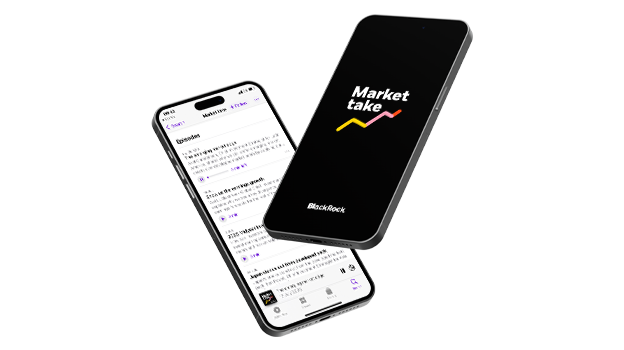Time to be more tactical
Weekly video_20250702
Wei Li
Global Chief Investment Strategist, BlackRock
SCRIPT
It can sometimes feel like the world has been upended this year. 2025 has brought sharp policy pivots. And uncertainty is everywhere. But we think this is just an acute manifestation of the new macro regime we’ve been describing for a few years.
While AI and other mega forces are transforming our world, they’ve also disrupted traditional long-term macro anchors like stable inflation and predictable growth.
To navigate this, The BlackRock Investment Institute has identified three key themes in the 2025 Midyear Outlook.
Bottom Line open/title: BlackRock Investment Institute 2025 Midyear outlook
First, investing in the here and now. Right now, we think we have more certainty about the near-term economic outlook than the long-term one – a reversal of usual investing logic. That’s because we see immutable economic laws limiting policy action and how fast the world can change. We put more emphasis on our shorter-term tactical investment views — and stay overweight U.S. equities.
Second, taking risk with no macro anchor. The volatile macro environment injects risk into portfolios that needs to be actively managed. But we think it is also a great environment for achieving alpha, or above-benchmark returns.
Third, finding anchors in mega forces. Even with the loss of long-term macro anchors, we believe mega forces are durable drivers of returns as they transform the world. But it’s important to keep tracking their evolution across and within asset classes.
The Bottom Line is: as we head into the second half of 2025, we think investors may navigate uncertainty by focusing on immutable laws that limit how fast the world can change – while leaning into the transformative mega forces shaping the future.
FOR PUBLIC DISTRIBUTION IN THE U.S., CANADA, LATIN AMERICA, AUSTRIA, GERMANY, FRANCE, ITALY, LIECHTENSTEIN, IRELAND, SPAIN, PORTUGUAL, BELGIUM, UK, LUXEMBOURG, SWITZERLAND, NETHERLANDS, NORWAY, FINLAND, SWEDEN, DENMARK, ISRAEL, SOUTH AFRICA, HONG KONG, SINGAPORE AND AUSTRALIA. FOR INSTITUTIONAL, PROFESSIONAL, QUALIFIED INVESTORS AND QUALIFIED CLIENTS IN OTHER PERMITTED COUNTRIES.
Immutable economic laws offer more certainty in the near term as long-term macro anchors weaken. That, and mega forces, keep us overweight U.S. equities.
U.S. stocks edged up to record highs on the AI theme. U.S. 10-year yields edged up as June payrolls data beat expectations, a sign sticky inflation will persist.
We are monitoring the expiration of the 90-day suspension of U.S. reciprocal tariffs announced on April 2 and watching for any indications of an extension.
Big policy shifts seem to have upended the world this year – but our 2025 Midyear Outlook puts them in perspective. We think immutable economic laws on global trade and U.S. debt limit how quickly the world can change. And while we see long-term macro anchors weakening, we think mega forces like artificial intelligence provide a new anchor. These two core features of this environment keep us risk on and overweight U.S. equities. Watch for more from our Outlook in coming weeks.
Limited rebounds
Ratio of European vs. U.S. equity total returns, 2001-2025

The figures shown relate to past performance. Past performance is not a reliable indicator of current or future results. Index performance returns do not reflect any management fees, transaction costs or expenses. Indices are unmanaged and one cannot invest directly in an index. Source: BlackRock Investment Institute, with data from LSEG Datastream, July 2025. Note: The chart shows the ratio of total returns in local currency for the Stoxx 600 over the S&P 500, with shaded areas highlighting when the Stoxx 600 outperformed the S&P 500 by more than 5% over a three- to six-month period.
As unusual as this year has seemed, we think it is a more acute manifestation of the profound transformation underway for a few years now. Long-term macro anchors markets have relied on for decades, like stable inflation and fiscal discipline, have weakened. But that does not mean investors should trim risk taking. Mega forces offer a new anchor for returns. And we see immutable economic laws limiting policy shifts and narrowing near-term outcomes: supply chains can’t be rewired overnight and U.S. debt sustainability relies on large foreign funding. So, we’re Investing in the here and now – and putting more weight on our short-term views. We think today’s economic setup still favors U.S. outperformance. European stocks have bested U.S. peers many times since 2000, including early this year, but it’s always faded. See the chart. We think Europe needs to advance its structural reforms to change that.
The recognition that immutable economic laws prevent fast deviation from the status quo allowed us to quickly dial risk back up after the April 2 tariff announcements. And we now see even more cause to stay risk on and overweight U.S. equities. The U.S. is set to enact tax and regulatory reforms that could boost investor sentiment. We see scope for overall corporate earnings to stay solid even if U.S. growth is dented by tariff-induced disruptions and corporate caution.
Getting active across asset classes
In fixed income, by contrast, we prefer euro area government bonds and credit over the U.S. Yields are more attractive in Europe than in the U.S. Yes, long-term U.S. Treasury yields may temporarily fall as markets price in rate cuts amid shifting narratives, but we think sticky inflation will keep the Federal Reserve from cutting far. Plus, high fiscal deficits may prompt investors to seek more term premium, or compensation for the risk of holding long-term U.S. debt. We also prefer local currency emerging market (EM) bonds as the U.S. dollar could weaken more and the EM growth outlook is brighter.
In this volatile environment, we think it is important to carefully manage macro risk: set-and-forget portfolios no longer serve investors well. We find other ways of Taking risk with no macro anchor. They include relative value – or positioning for prices of different securities to converge or diverge – liquidity, regulation and positioning risk. Another way we inform our risk-taking is by Finding anchors in mega forces. We believe they will be durable drivers of returns in both the near and long term.
Across all asset classes, greater dispersion in market and security returns means more opportunity to capture alpha, or above-benchmark returns. Take mega forces as an example. They don’t provide a clear handle on the growth and inflation outlook, unlike macro anchors, and don’t map into broad return drivers. Instead, we need to track their evolution across and within asset classes, get granular with themes and constantly adapt to what’s priced in. Getting active applies across both public and private markets – and we see greater blending of the two within portfolios. Look out for more on just how exceptional this environment is for alpha in coming weeks.
Our bottom line
As long-term macro anchors weaken, we find new ones in mega forces and lean more on our short-term views as immutable economic laws limit the pace of change. We stay overweight U.S. stocks and get active across asset classes.
Market backdrop
U.S. stocks edged up to fresh record highs, with the AI theme taking the lead again. The S&P 500 more than fully recovered from its nearly 15% slide after the April 2 U.S. reciprocal tariffs announcement to end up about 11% in Q2 and up 26% from April lows. U.S. 10-year yields edged up to 4.35% after payrolls increased 147,000 in June, beating expectations. We think that highlights how job creation and wage growth would need to slow much more for inflation to settle at the Fed’s 2% target.
This week, we are monitoring the expiration of the 90-day suspension of U.S. reciprocal tariffs announced on April 2. Negotiators from over a dozen U.S. trading partners are working to finalize an agreement before the deadline. Only the UK and Vietnam have reached a deal so far. Yet an immutable law – supply chains can’t be rewired overnight without serious disruption – means we don’t anticipate tariffs will return to April 2 highs. We watch to see if the pause gets extended.
Week ahead

Past performance is not a reliable indicator of current or future results. Indexes are unmanaged and do not account for fees. It is not possible to invest directly in an index. Sources: BlackRock Investment Institute, with data from LSEG Datastream as of July 2, 2025. Notes: The two ends of the bars show the lowest and highest returns at any point year to date, and the dots represent current year-to-date returns. Emerging market (EM), high yield and global corporate investment grade (IG) returns are denominated in U.S. dollars, and the rest in local currencies. Indexes or prices used are: spot Brent crude, ICE U.S. Dollar Index (DXY), spot gold, MSCI Emerging Markets Index, MSCI Europe Index, LSEG Datastream 10-year benchmark government bond index (U.S., Germany and Italy), Bank of America Merrill Lynch Global High Yield Index, J.P. Morgan EMBI Index, Bank of America Merrill Lynch Global Broad Corporate Index and MSCI USA Index.
U.S. tariff pause deadline; China CPI
China total social financing
Read our past weekly market commentaries here.
On the go?









Past performance is not a reliable indicator of current or future results. It is not possible to invest directly in an index. Note: Views are from a U.S. dollar perspective. This material represents an assessment of the market environment at a specific time and is not intended to be a forecast or guarantee of future results. This information should not be relied upon as investment advice regarding any particular fund, strategy or security.